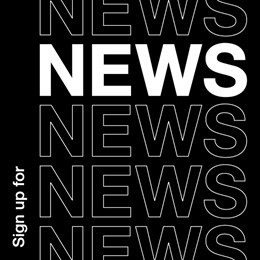Type as the communicator of change

Marie Sylvester, editorial lead at Kittl, explores how typography serves as a powerful communicator of change – forming visual stories that respond to global issues such as social unrest, climate change and AI advancements.
Throughout history, letterforms have carried the weight of revolutions. Scrawled across canvas and cardboard, type doesn’t just speak; it resonates, disrupts and inspires action. It leads the charge, shaping narratives and visually communicating societal shifts. Today, designers, activists and brands continue to push type beyond words, leveraging it as a key component of design to craft visual stories that connect global audiences and drive meaningful change.
Raw, unpolished and unapologetically authentic – handcrafted typography has long been at the forefront of activism. Protest posters and rally banners embrace scrawled lettering and imperfect strokes to symbolise urgency. With more marches on the streets and televised calls for social change, we’re seeing these charismatic letterforms rise in use.
This type of typography is all about impact. Hastily scrawled letters tell a visual story of passion, frustration and hope. The text isn’t just readable; it's felt.
Simultaneously, clean, bold type is being used to send a message as straightforward as its letterforms. It requires no embellishment, no explanation. The power is in its sharp contrast and simplicity.

Uber / Branda Agency / Designers: Danielle Hawley, Rick Serdiuk, and Egor Petrov
At the same time, a new disruptor has entered the space: AI-generated typography. No longer confined to traditional forms, letters are being twisted into abstract shapes, morphed into intricate visuals that challenge what we thought was possible with digital precision. Pushing the boundaries of written communication, text is now a thought-provoking design element in its own right. It’s a powerful way to amplify creative expression, creating immersive experiences and conveying deeper meanings.
This is more than just new tech – it’s a reflection of our continuous desire for creative experimentation and growth.
Imagine an eco-conscious spring water brand whose identity is rooted in sustainability. Their hero text isn’t just written – it feels real. The letters appear raw, sculpted from crystal-clear water, embodying purity and renewal. The texture subtly reinforces their mission, crafting a silent yet powerful story of a clean world. This AI-generated typography doesn’t just display a word – it immerses the audience in the brand’s values, making sustainability tangible at first glance.

AI-generated image in Kittl
More than just a visual tool, AI typography is redefining how words are seen, read and experienced.
However, as designers explore this new capability, they need to keep originality and ethical design in mind, using it as an extension of human creativity rather than a replacement. Think of it as a creative companion that allows people to see and feel the essence of your brand or mission in a single visual snapshot.
And as brands become more eco-conscious, the make-up of typography is following suit. Designers are now considering sustainability not just in materials but in the very essence of type itself – creating fonts that use less ink, require minimal space and enforce environmental values through design. But lighter-weight typefaces, condensed letterforms and open counters are doing more than reducing ink consumption in print – they’re making a statement about consumption.
Typography and design have long formed an ongoing conversation with the ideas shaping our world. Our partners at Monotype explore these themes further in their just released 2025 trends report, Re:Vision, Future Typography, turning a creative lens on how typography and design shape and reflect the cultural themes impacting our future.
Typography is one of your strongest allies in conveying messages that run far deeper than the written word. As we continue to push the boundaries of typographic expression, one thing is certain: Typography isn’t just mirroring global shifts – it’s a key communicator of them.













